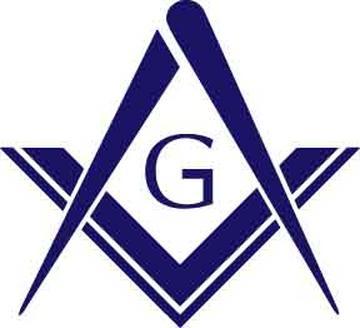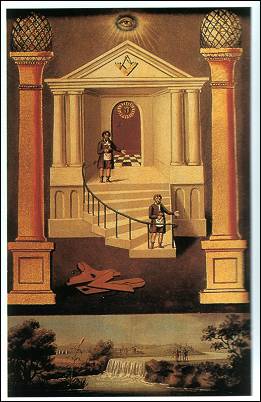
Masonic Symbols described
 Few things are more controversial than the
descriptions of Masonic symbols and how they should be
interpreted. Some Masonophobes have created entire publishing industries based
on their own interpretation of such symbols, often with no factual information
to support their claims. They include every logo of a company, every mark in a
tree, and more. Anything, it seems with a circle, triangle, or square comes into
question - and unfortunately, it's easy to get sucked into the vortex of such
convoluted thinking.
Few things are more controversial than the
descriptions of Masonic symbols and how they should be
interpreted. Some Masonophobes have created entire publishing industries based
on their own interpretation of such symbols, often with no factual information
to support their claims. They include every logo of a company, every mark in a
tree, and more. Anything, it seems with a circle, triangle, or square comes into
question - and unfortunately, it's easy to get sucked into the vortex of such
convoluted thinking.
So before we begin, let's start with a basic premise: if the Masons - or the evil corporations - can't use a CIRCLE (or any part of it) or a TRIANGLE (or any part of it) or even a square box, just how are they going to draw ANYTHING? Should our traffic signs be in the shape of a cucumber? Should our representations of the sun look instead like a fish? Elemental shapes in nature have ALWAYS been used because of simplicity, not because there was some inbred evil in every thing that was ever done....
What do they mean - Specifically?
First, it is important to understand that Masonic Symbolism does not represent an idea that has only one single and unequivocal meaning. In reality, the symbols encompass three things, all closely related but not actually identical.
| There is "Personal Symbolism" in which the interpretation comes from the individual thinking of each person. It is from this source that much of the 'rubbish' surrounding Masonic symbols derives. Any person can make any claim about this or that symbol - and many early Masonic writers did! Their plethora of works gives rise today to the fanciful claims by those who seize upon the earlier (and far more 'dramatic') prose of a century ago to make false charges about 'true meaning'. | |
| In contrast, there is "Masonic Symbolism" in which specific symbols are explained by recognized Masonic sources and, particularly, by specific explanations right in the ritual. | |
| And lastly, there is "Comparative Symbolism" - in the same sense as one might commonly use the word "Comparative" in the study of Comparative Religion, wherein various religions are studied and compared from the standpoint of similarities and differences. |
As a further clarification, it is important to consider the fine distinction between the term (and idea) of SYMBOL and EMBLEM. A Symbol serves as an outward sign of something else while an Emblem does not necessarily have this 'something else' connotation. For example, a five-pointed star can be an emblem of a peace officer or to indicate the rank of general and yet used in a religious context, can come to have a spiritual meaning.
But there are SO many in Freemasonry.... Why?
 Freemasonry
was formed at a time when there was VERY little written material. The cost of
even a single piece of paper was about equivalent to a fine meal today and
compared to other essentials - like food - it was enormous. As a result, early
Masons would draw the symbols which were spoken of in the ritual on the lodge
room floor in chalk. At the end of the meeting, the floor was simply washed.
However, the symbols - pictures - that were drawn could be easily remembered by
those present.
Freemasonry
was formed at a time when there was VERY little written material. The cost of
even a single piece of paper was about equivalent to a fine meal today and
compared to other essentials - like food - it was enormous. As a result, early
Masons would draw the symbols which were spoken of in the ritual on the lodge
room floor in chalk. At the end of the meeting, the floor was simply washed.
However, the symbols - pictures - that were drawn could be easily remembered by
those present.
Freemasonry teaches many important lessons among which are temperance, fortitude, prudence, and justice as well as brotherly love, relief and truth. The degrees of Freemasonry seek to teach those lessons through allegorical stories whereby a candidate will progress on a flight of winding stairs in a quest. (The journey/quest is one of the oldest concepts of mankind and is found in essentially every facet of human nature beginning with our need for food to continue life.) In order to help the candidate remember the importance of the journey, he is introduced to various SYMBOLS along the way. Later, he will remember that, for example, that the beehive teaches him to be industrious.
And they don't always 'fit'
Particularly when one considers Masonic bodies created within the past 100 or so years by a single individual (or small group), the symbols (and emblems) adopted were nearly always the work of one individual's imagination rather than some secret (and evil) 'hidden meaning'. When a person doodles a star or circle or square while waiting for another to answer the phone, do they really contemplate (or even know) the centuries of history of that 'symbol'? Of course not.... Similarly, when an actor in New York was outlining his vision for what became the Shrine or a mid-west Minister was looking for motivation for a women's organization, it is well beyond a stretch of imagination to presume that they were imbued with evil and esoteric influences stretching back into the mists of time.
An exhaustive recitation of each and every bizarre interpretation made throughout the past 300 years by the small, vocal opposition to Freemasonry is far beyond the scope of this web site (and likely beyond the interest of its readers). Suffice it to say, however, that any graphical representation of Freemasonry should be viewed within the context of what Masonic ritual actually says about such a symbol rather than what others have personally attributed to it!
![]()
For those with a particular interest in this subject, this web site's author recommends the following:
Sources of Masonic Symbolism by Alex Horne. Missouri Lodge of Research, 1981. Not quite 100 pages in length, this work will provide you with more knowledge about Masonic Symbolism than you could find in a dozen other books of five times its size. An outstanding reference!
Signs and Symbols - Their Design and Meaning by Adrian Frutiger. (Translated from the German by Andrew Bluhm). Watson-Guptill Publications, New York. 1998. ISBN: 0-8230-4826-8. This book will help you appreciate that an oblong line or a simple curve has meanings far beyond that which might have imagined - and from this simple understanding will help you appreciate the fact that those who use (or abuse) Masonic symbolism might not understand what they're talking about!
Some additional resources on signs/symbols are summarized here.
![]()
|
Related Topics: |
|
In addition, |